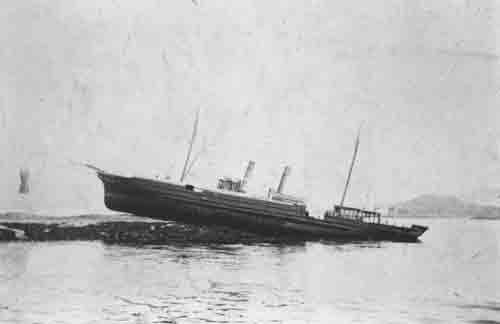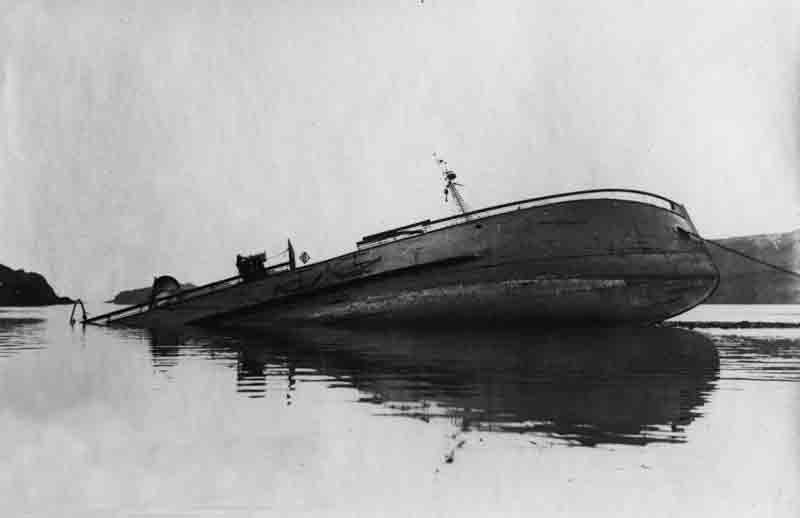In a short period of ten fateful days from the 27th January to the 6th February, 1918, within a few square miles off the north coast of Ireland, the British war effort suffered three heavy blows with the loss of the SS Andania on the 27th of January, then SS Aurania on the 4th February followed by the SS Tuscania the next day. All three were liners built for the Transatlantic trade requisitioned by the Admiralty to be used as troop carriers and were employed in this service bringing US troops from the States to the battlefields of Europe and all were sunk by torpedoes from German U-Boats in the western approaches to the North Channel.
The Aurania was launched on 18th July 1916 from the yard of Swan Hunter and Wigham Richardson Ltd. of Newcastle (Yard No 965). She was a large steel hulled passenger cargo steamship of 13,936 gross tons, 8499 net tons and her dimensions were 520.5′ x 64.8′ x 42.6′. She was powered by 4 Parsons steam turbines by the Wallsend Slipway and Engineering Co Ltd delivering 8500 shaft horse power.
The Aurania made her maiden voyage from Tyne to New York on 28th March, 1917 and by early 1918 had completed seven successful war time Atlantic crossings. After unloading her compliment of around 2000 soldiers from this trip, on 3rd February she set out again from Liverpool, bound for New York, to pick up yet another consignment of young American troops. She was unescorted, relying on her speed to avoid any enemy submarines she might encounter. Meanwhile, Kapitanleutnant Erhard Schulz, commander of the German submarine UB-67, had been ordered to take his U-boat and join his fellow countrymen lying in wait for the approaching troop carriers off the north coast of Ireland. German High Command in Berlin knew that if they did not stem the flow of troops from across the Atlantic the war would be lost.
Schulz could not believe his luck when, soon after arriving at his station, the Aurania steamed into view. He fired three torpedoes at her and saw and heard at least one hit her on her port side before diving to escape from the vicinity and the attentions of any escort ships. On board the Aurania all hell had broken loose. The torpedo had made a direct hit in the engine room area, instantly killing eight crewmen and flooding the boiler room. Her fires were soon extinguished by the rising water and she was dead in the water but at least she was still afloat. The steadily increasing wind was blowing from the west and was slowly but surely pushing the stricken ship towards the Irish coast. The crew had no choice but to abandon her. She drifted ashore in County Donegal but was quickly refloated and taken in tow, bound for the Clyde to be repaired. The fate the Cunarder was to have one final twist because, as she was being towed towards the Clyde, the tow lines snapped and she drifted north along the Scottish coast before finally coming ashore for a second and last time on the north west corner of Mull at Caliach Point. The huge ship was quickly smashed to pieces by the surging swell pounding against the rugged cliffs.
Aurania slideshow
After the end of the war the Aurania was heavily salvaged by James Gush of Greenock but still remains a fascinating wreck. In June 1980 Northampton Branch of the British Sub Aqua Club found and recovered the impressive hoard of Cunard silver that had been securely stored aboard the ship despite her wartime duties.
The wreck lies about 100 metres off shore just south of Caliach Point in position 56°36.142’N, 006°19.505’W (WGS84) in depths from 15 – 20 metres although there is also a lot of small pieces of wreckage nearer the shore in shallower water.
The most impressive items of wreckage are her massive boilers which sit 6 or 7 metres proud of the seabed but there is a mass of other tangled wreckage spread across a wide area. Visibility in the area is generally very good making this a terrific wreck site. The site is very exposed to the prevailing wind and swell and is also subject to current at some states of the tide. Care must be taken not to wander into the overfalls which form just north of the wreck site off Caliach Point itself.
We would like to thank Lloyd’s Register Foundation – Heritage & Education Centre for allowing us to reproduce documents from their archive in this article.
We would like to thank Fiona Houston for her permissions to use her underwater photographs of the wreck.












































